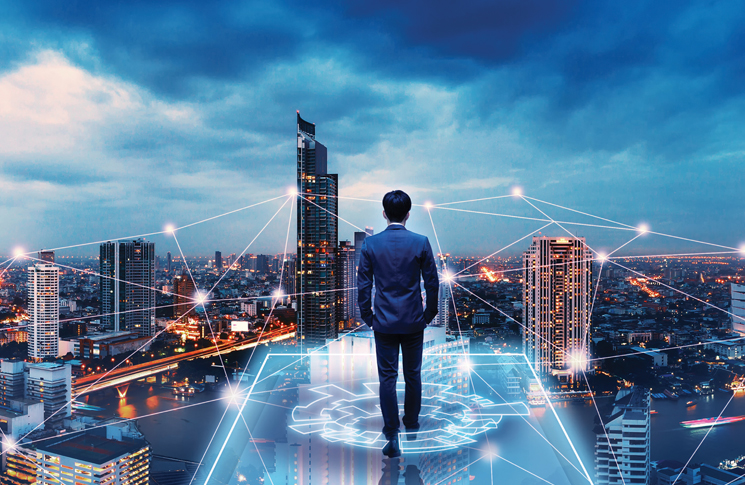They are coming to a sky near you, using the features and limitations of their technology to create a new form of aviation
Roads?
Where we’re going, we don’t need roads!
– Emmett ‘Doc’ Brown in Back to the Future
Catch me if you can
The world’s advanced aerial mobility (AAM) landscape is bursting at the seams with new developments – and safety authorities are well aware of the need to keep up.
The convergence of drone, car, aircraft, advanced computer and new fuel technologies is creating a breathtakingly diverse and unconventional environment – an environment where safety of participants is still paramount, regulatory structure to support safe flight still necessary and infrastructure (both physical and procedural) still needs to be developed.
However, it is the very unconventional nature of the landscape that provokes both excitement and reticence and presents the greatest challenges to aviation’s century-old status quo.
Unconvential
Quadcopters, tri-copters, box-configuration electric vertical take-off and landing (eVTOL) aircraft, folding-wing, folding-rotor, multirotor, short take-off and landing very light jets, tilt rotors, ducted-fan models, hover bikes and all manner of in-between and hybrid variants – unconventional aircraft configurations are fast materialising.
As the aviation industry seeks to move to cleaner fuel options, limitations of conventional non-fossil fuel technologies are apparent. Until such time as sustainable aviation fuels can fill the tanks of airliners, or that longed-for quantum shift in battery technology enables electrification of 737 fleets, many pioneers of advanced aerial mobility technologies, developers and investors, are looking to disrupt personal mobility norms to create viable markets for their smaller electrically propelled product. Historically, grassroots developments can be what ultimately drives larger commercial applications.
eVTOLs are the most likely contenders
Worldwide, eVTOLs are increasingly being recognised as realistically disrupting personal mobility. Be it crewed or uncrewed (‘optionally piloted’), these often drone-like, electrically driven, multirotor configurations are progressively more visible and have attracted, by far, the most serious investment (an industry predicted by Wall Street to be worth US$1 trillion by 2040) and the most attention by regulators.
The development of increasingly lightweight construction materials and enhanced battery capacity has significantly increased eVTOL viability in recent years. Further, and certainly for Australia, eVTOL offers broad potential applications in regional areas and reduced ground-bound traffic congestion in urban areas.
But these aircraft are more than the perfect storm of materials and technology, producing a promising, efficient configuration for a demonstrably keen market (some designs claim to use fewer kilowatts per hour of energy in cruise than an electric car). There are enhanced safety characteristics that have developers urging regulators to keep up, and regulators keen to do so.
Safety
For any conventional helicopter pilot, it would be more than a little counterintuitive to imagine having 5 rotors (or, heaven-forbid, 8!) is less fallible than 2. With more moving parts counteracting aerodynamic forces than the entire suite of Cirque Du Soleil shows in one performance, there’s more than one reason the part holding it all together in a helicopter is nicknamed the Jesus nut.
For VTOL aircraft, electric motors change everything – and electric propulsion distribution changes everything else.
More rotors but fewer moving parts
With just a small number of parts, electric motors in eVTOLs drive the rotor directly, with very little gearing and far fewer points of possible failure. However, just as an engine failure in a twin-engine fixed-wing aircraft causes an asymmetrical thrust issue, an electric motor failure in a multirotor is still problematic.
The solution? Even more electrically propelled rotors. In an asymmetric situation, the flight management system instantly calculates where it needs counteracting thrust and the electric propulsion distribution system instantly redirects the energy around the matrix of rotors.
Electric propulsion distribution also offers more precise and effective control of thrust in normal flying conditions by speeding up and slowing down rotors in different patterns.
Some designs claim to use fewer kilowatts per hour of energy in cruise than an electric car.
More fail safe
Electric motors are, in general, far more reliable than internal combustion engines, mainly due to their simplicity, and require significantly less maintenance; each time a human touches a part or reassembles an engine, it creates a failure opportunity. And, as electric motor ‘fuel’ is simply electrons running along wires from batteries to the motors, reliability is increased. The likelihood of fuel starvation is also reduced and mitigated easily by redundancy.
Further, batteries are increasingly able to (within reason) predict failure, shutting down and drawing instead on often multiple redundancy systems.
Reduced workload
Although VTOL craft are more closely related to helicopters in terms of flight characteristics, it seems they do not require the extraordinary skill of a heli pilot to successfully take-off, fly and land safely.
For example, consider the Joby offering. Joby’s eVTOL has hand-held controls (no foot pedals) consisting of a speed control (throttle) and a bank, pitch and yaw (directional) control. Turn left? The fly-by-wire control system sends signals to each of the relevant motors, telling them to immediately distribute more (or less) energy to each propeller, and tilt if appropriate, to create the correct thrust profile required to go left.
To take off, simply power up and pull back the directional stick a little. Up the craft goes. Let go of the directional stick and the power and the eVTOL hovers – airborne and stable. Compare that to the mental workload of a Cessna 172 or a tail-dragger Decathlon take-off. The human brain is not great at multitasking, no matter what it likes to tell itself.
In just this one aspect, by reducing the necessity for feet to help direct an aircraft, this eVTOL has inherently simplified the pilot’s cognitive load.
The Joby eVTOL can hover and fly backwards and is speed limited to single-digit knots when near ground as an automated safety mechanism and to ensure precision take-offs and landings.
It would be a hard case to argue aviation should stick with the status quo if the eVTOL’s new ‘way of doing things’ holds the promise of reduced pilot workload.

Regulating, certifying and licensing
In the paperwork department, and to avoid a ‘wild, wild west’ scenario in the air, aviation’s safety regulators are busy exploring and consulting the public and industry on the required regulation.
Typical of new aviation technologies, the pathway to certification is a ‘push me, pull you’ scenario until such time as the technology becomes established. Developers argue their case and the regulator reacts by expanding, contracting and streamlining rules, aiming for
safe outcomes.
The US and the European Union are taking very different approaches to the development of regulatory structures.
The US Federal Aviation Authority (FAA), together with the UK’s Civil Aviation Authority, have recently released a joint statement, ‘focused on facilitating certification and validating new eVTOL aircraft, production, continued airworthiness, operations, and personnel licensing’. Taking the approach of tailoring existing regulations – if the design is a close enough match to a particular category – certification may occur through an established process. If the eVTOL does not fit a category, it may be considered on a case-by-case basis.
After public consultation, the European Union Aviation Safety Agency issued a Means of Compliance with the Special Condition VTOL document that attempts to address the breadth of emerging VTOL configurations.
In May 2021, the Australian Government’s Department of Infrastructure, Transport, Regional Development and Communications released the National Emerging Aviation Technologies Policy Statement. The document outlines the department’s approach to ‘progressing a range of coordinated initiatives on rules and enforcement, infrastructure development, legislative change programs and utilisation of technology’.
Some of its key eVTOL initiatives include:
- a planning framework for take-off and landing sites
- airspace access and management
- cost recovery for the development of new infrastructure or regulatory structures
- pilot training and licensing
- technical and maintenance standards
- approval processes for testing and trialling.
VTOL craft … do not require the extraordinary skill of a heli pilot to successfully take-off, fly and land safely.
CASA is working with international regulatory colleagues (such as the FAA) to ensure that advanced air mobility eVTOL aircraft are approved to meet internationally recognised and harmonised airworthiness safety standards. CASA is also developing the RPAS and AAM Strategic Regulatory Roadmap to ‘provide clarity about Australia’s future approach to aviation safety regulation and safety oversight for RPAS and AAM’.
Emerging niches
Signs of product differentiation are emerging even before electric aircraft come to market. In Germany, Volocopter is developing an aircraft for urban air mobility and Lillium is developing a type that will specialise in longer ‘regional air mobility’ flights.
‘Lilium envisions directly connecting inner towns and cities across ranges of between 40 and 200 km at launch (and up to 500 km longer term) at speeds of up to 300km/h, while enabling significant time savings for individual passengers compared to alternatives,’ the company’s chief technology officer, Alastair McIntosh says.
McIntosh concedes that Lillium’s architecture of tilt in wings and ducted fans is less efficient in vertical lift than the low disc loadings of its open rotor rivals. But the payback for ducted fan propulsion is in speed and range. In Australia, AMSL Aero Pty Ltd, founded by Andrew Moore and Siobhan Lyndon, designed the Vertiia with aeromedical, emergency services and passenger market applications in mind. The Vertiia is still in the testing and trialling stage with computer modelling and engineering simulator activities underway.
David Lamb is part of Vertiia’s test pilot program, operating under an experimental certificate. He supports a careful approach to developing eVTOL licensing, airworthiness and certification regulation. ‘If there’s a more conservative approach to new technologies, ultimately it might be in everyone’s best interest,’ he says. Getting the regulation right in the first place might mean better outcomes for the entire industry.
One certification story of note is Opener’s BlackFly – a fixed-tandem-wing, tilt-body, multirotor eVTOL, with more than 4,300 flights logged. Certified for use without a pilot licence in the US ultralight category (training still necessary), it is the length of an average car, over twice the width but weighs only around 156 kg.
Opener’s international version is not speed limited and has a range of 40 nm.
Under the existing ultralight regulations, software limits the BlackFly’s speed to 55 knots and the energy equivalent of around 23 litres of fuel. Under these limitations, the BlackFly has a 25-minute (plus 20-minute reserve) range.
However, Opener’s international version is not speed limited and has a range of 40 nm, meaning it could be certified elsewhere in an entirely different category, perhaps increasing its commercial prospects.
Conventional minds
Aside from regulatory development keeping up with the pace of emerging AAM technologies, one of the biggest challenges facing the integration of eVTOLs into urban or regional mobility or as personal aerial vehicles, is fear of, and resistance to, change.
However, for progress to occur, fear is an inherent part of the process. As Burt Rutan, the godfather of unconventional aircraft design, once said, ‘Breakthroughs are what define our species, they come about because we are threatened’.
Autonomous eVTOL taxis or unpiloted airliners appear to be a long way from acceptable to society. Piloted aircraft are still perceived as less risky, both to humans onboard and on the ground, even when the technology may be new. But with every successful manned eVTOL flight adding certainty to the knowledge base, every incident also being an opportunity for improvement, and each step proving or disproving its underlying concept, change is inevitable in technology, attitudes, or both.





